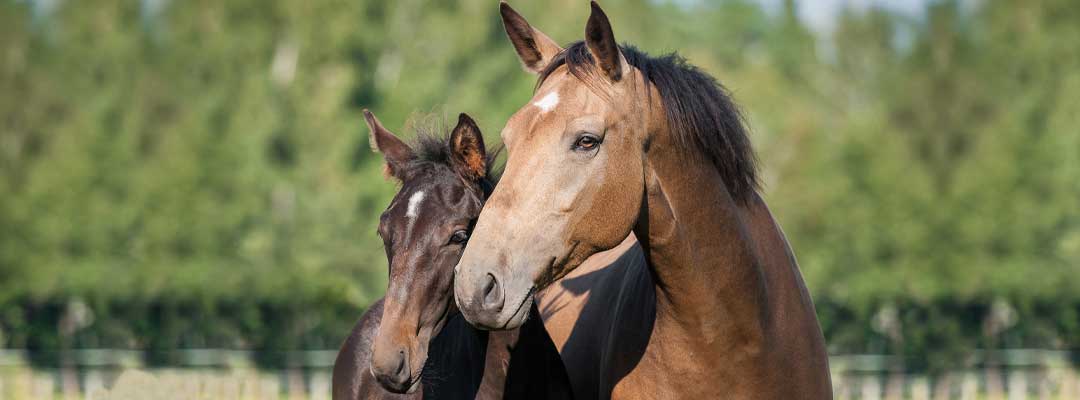Breeding Horses? One Broodmare's Story

One can never worry about asking a “dumb question,” especially when it involves something as intricate as breeding horses. Mackenzie Morrison, owner and trainer of River Boyne Farm -- a breeding, training and lesson barn established in 2016 -- immersed herself into equine reproductive management courses to learn as much as possible about breeding horses. She absorbed industry knowledge like a sponge from well-established professionals, and kept a close relationship with her veterinarian always. At her farm in northern Michigan, she has anywhere from 22 to 27 horses at any time -- including broodmares, foals and stallions, many being Connemara or Gypsy Vanner.
“I want to know I’m doing the best I possibly can for them,” Mackenzie said. “I want to learn all the time and am not just going to hope for the best. To me, they’re not just broodmares. They are not just money producers. They are a part of the family.”
She posted to the active Facebook group Horse Vet Corner? when she feared her broodmare MV Tupelo Honey (Gypsy Vanner, age 7) was becoming almost narcoleptic during her pregnancy. She was experiencing sleep deprivation. When her broodmares are close to foaling, Mackenzie sleeps in a bedroom viewing into the main foaling stall. That’s when she noticed that, “The mare’s knees would buckle, then she would sway and drop to the ground. I was concerned with her falling and that she may bruise the placenta and hurt the baby,” she said. Approved veterinarians of the group quickly commented with advice and assurance.
“No question is a dumb question,” Mackenzie urged. “There isn’t just one way of doing things, and someone might have another idea. Every horse is an individual; it isn’t ‘textbook,’ and each pregnancy is different, too.”
This mare in question had two unique challenges Mackenzie would help her overcome.
CHALLENGE ONE: Keeping Her in Foal
“We always had a hard time keeping this mare in foal, because she would experience Early Embryonic Death (EED),” Mackenzie said.
EED affects some 15% of pregnancies detected at day 15 after ovulation, according to the report “How to Manage Early Embryonic Death” written by Tom A.E. Stout, VetMB, PhD. Dr. Stout’s report continued, “Moreover, the majority (60%) of these losses occur before day 42 after ovulation, a period when pregnancy maintenance is critically dependent on progesterone produced by the primary corpus luteum (CL), and when a number of essential developmental events take place.”
A report from the American Association of Equine Practitioners (AAEP), authored by Atwood C. Asbury, DVM, DACT, stated that a possible defect of early embryonic loss is inadequate progesterone secretion. “â?¦ many breeders supplement progesterone or synthetic compounds with similar actions such as altrenogest during early pregnancy. Progesterone causes the cervix to remain tightly closed, the uterus to remain firm and helps block production of prostaglandins (hormones that arise from inflammation in the uterus).”
Mackenzie would give MV Tupelo Honey a daily dose of Regumate and SMZs twice a day. “We started her on Regumate and SMZs due to suspected placentitis with her early bagging up. Sometimes, Regumate throughout an entire pregnancy is warranted,” she said.
CHALLENGE TWO: Loss of Milk and Colostrum
Mackenzie keeps detailed notes of when her broodmares begin bagging up and any change in their behavioral attitude during their pregnancy. It helps her be prepared for the unexpected, by knowing what on average is to be expected.
“The industry standard is a 340-day ‘due date,’ but there is no real due date. It’s a guestimate. This mare started bagging up at 308 days this time but in 2019, she was bagging up at 290 days. She had wax and was dripping milk. She would be foaling any day now, and it was concerning,” Mackenzie said.
If she was dripping milk, she was losing colostrum, which is the first milk a mare produces. Rich in antibodies, colostrum is critical to foal health, protecting newborn foals against infectious agents during the first few months of life until their immune system fully develops. It is important that foals consume and absorb colostrum within six to 12 hours following birth.
“The mare dripped milk two weeks before foaling. It was white, watery milk -- no colostrum in it,” Mackenzie said. That’s when she decided to order Seramune from ValleyVet.com . Made from equine serum, Seramune provides instant, reliable protection and gives foals enough infection-fighting proteins called antibodies (or immunoglobulin G -- IgG).
“I ordered it at 1:40 p.m. I was checking tracking, and it mailed before 2 p.m., with UPS tracking estimating delivery of 3:15 to 5 p.m. the next day,” Mackenzie said, who plans to have it on hand every season as a just-in-case measure. “I found the UPS driver downtown and picked it up off the truck. They knew it was an emergency. The Seramune and frozen colostrum worked wonders, and the foal had a wonderful IGG [level]” soon following her birth.
Overcoming these challenges, the broodmare had a successful pregnancy and a healthy foal. Newly minted RBF Call Me Honey is zipping around their paddock, full of vigor and doing well. “We are already so in love with this little girl and her sweet and bold personality,” said Mackenzie.



